Marketing Intelligence and Consumer Behavior Analysis for TOPSHOP
VerifiedAdded on 2020/07/23
|18
|4021
|53
Report
AI Summary
This report provides a comprehensive analysis of marketing intelligence, specifically focusing on the multinational brand TOPSHOP. It delves into the core aspects of marketing, including advertising, sales, and public relations, while emphasizing the importance of understanding customer needs and behaviors. The report examines the customer purchase decision-making process, detailing the steps from problem recognition to post-purchase evaluation. It explores various theories of buyer behavior, such as perception, exposure, and social status theories, and identifies factors influencing consumer behavior, including psychological, social, cultural, and economic influences. The report also investigates the relationship between brand loyalty, repeat purchasing, and corporate image, highlighting their interconnectedness. Furthermore, it discusses various market research techniques, differentiating between primary and secondary research methods, and providing sources of secondary data. The report also addresses the validity and reliability of findings in market research, and concludes with an overview of a marketing research plan. The report aims to provide insights into how TOPSHOP can enhance its marketing strategies to achieve its goals.
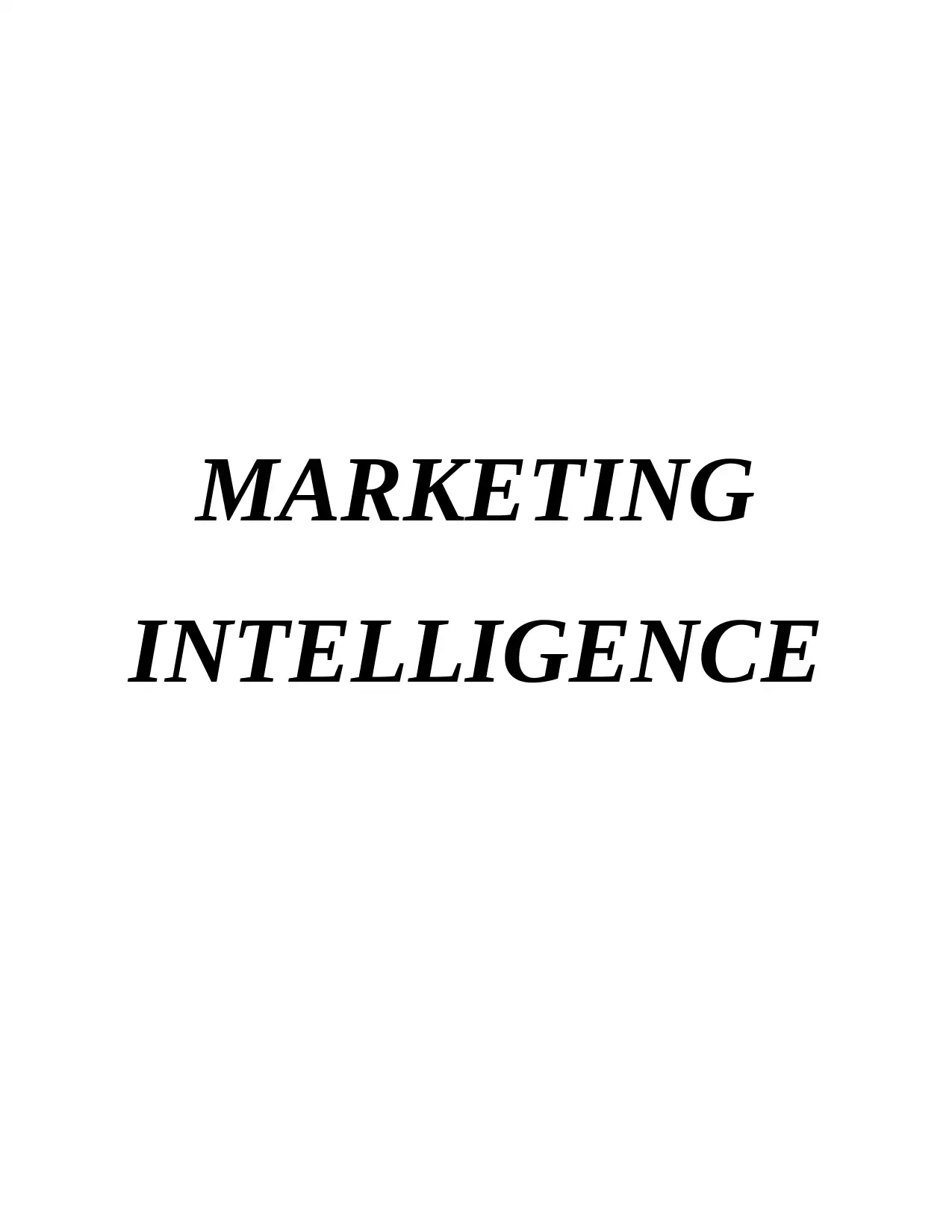
MARKETING
INTELLIGENCE
INTELLIGENCE
Paraphrase This Document
Need a fresh take? Get an instant paraphrase of this document with our AI Paraphraser
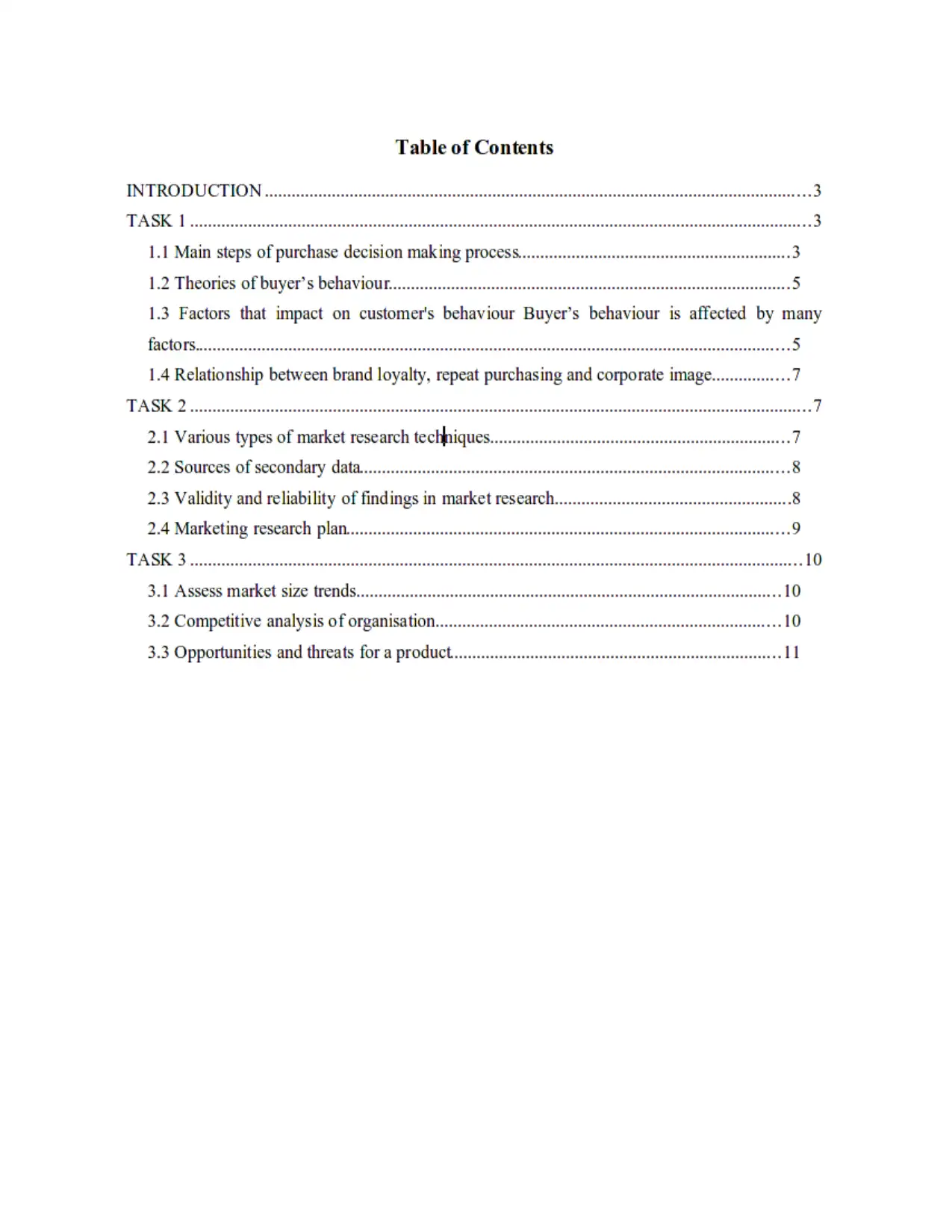
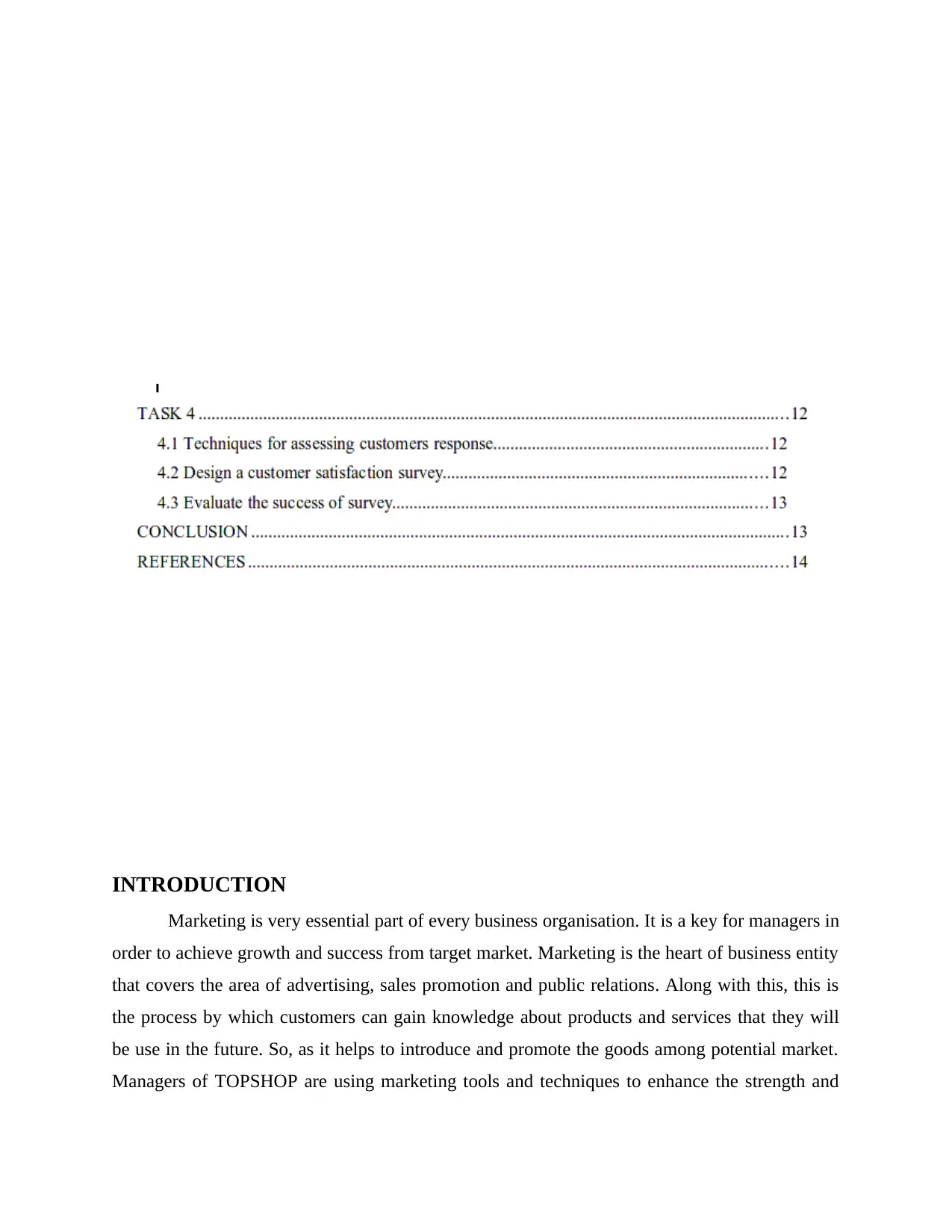
INTRODUCTION
Marketing is very essential part of every business organisation. It is a key for managers in
order to achieve growth and success from target market. Marketing is the heart of business entity
that covers the area of advertising, sales promotion and public relations. Along with this, this is
the process by which customers can gain knowledge about products and services that they will
be use in the future. So, as it helps to introduce and promote the goods among potential market.
Managers of TOPSHOP are using marketing tools and techniques to enhance the strength and
Marketing is very essential part of every business organisation. It is a key for managers in
order to achieve growth and success from target market. Marketing is the heart of business entity
that covers the area of advertising, sales promotion and public relations. Along with this, this is
the process by which customers can gain knowledge about products and services that they will
be use in the future. So, as it helps to introduce and promote the goods among potential market.
Managers of TOPSHOP are using marketing tools and techniques to enhance the strength and
⊘ This is a preview!⊘
Do you want full access?
Subscribe today to unlock all pages.

Trusted by 1+ million students worldwide
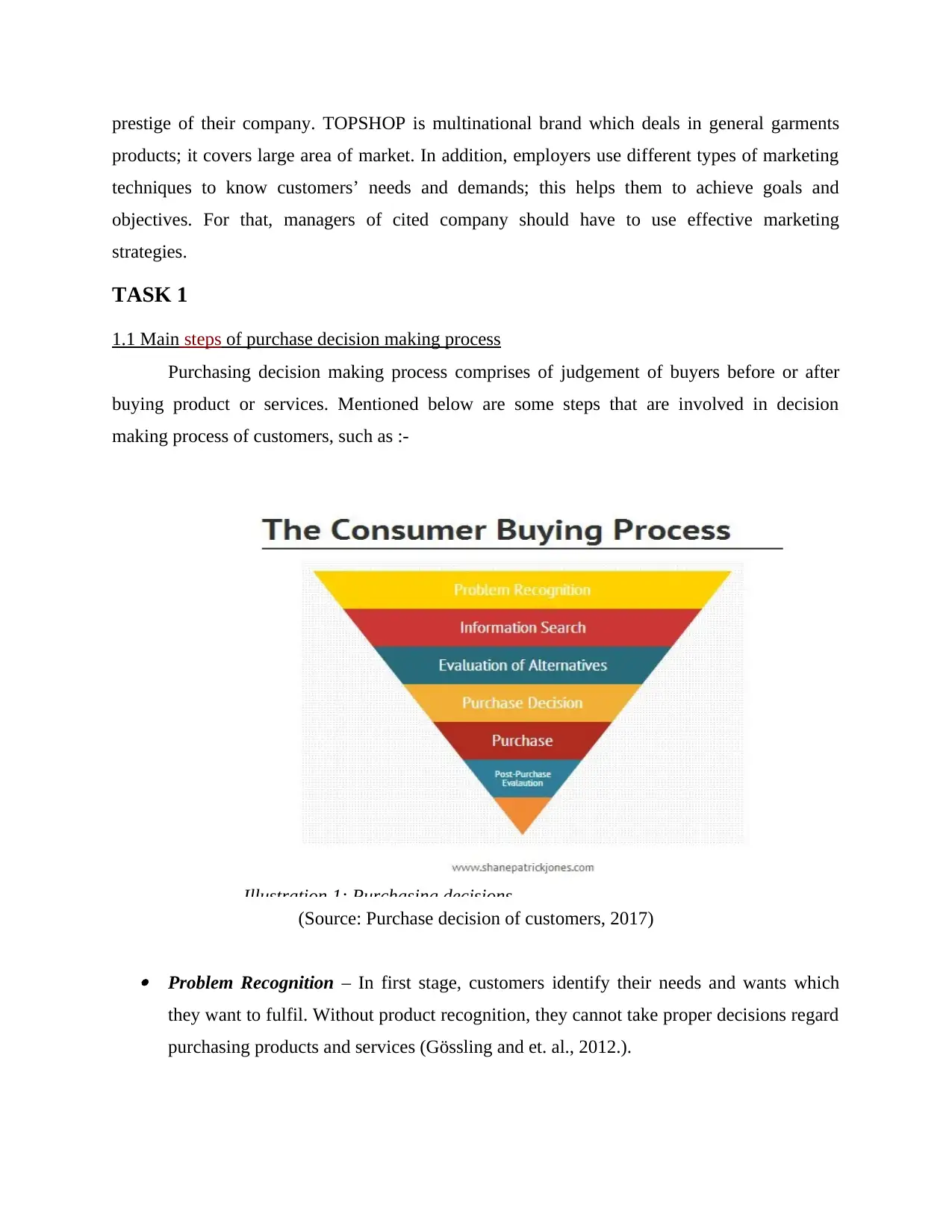
prestige of their company. TOPSHOP is multinational brand which deals in general garments
products; it covers large area of market. In addition, employers use different types of marketing
techniques to know customers’ needs and demands; this helps them to achieve goals and
objectives. For that, managers of cited company should have to use effective marketing
strategies.
TASK 1
1.1 Main steps of purchase decision making process
Purchasing decision making process comprises of judgement of buyers before or after
buying product or services. Mentioned below are some steps that are involved in decision
making process of customers, such as :-
(Source: Purchase decision of customers, 2017)
Problem Recognition – In first stage, customers identify their needs and wants which
they want to fulfil. Without product recognition, they cannot take proper decisions regard
purchasing products and services (Gössling and et. al., 2012.).
Illustration 1: Purchasing decisions
products; it covers large area of market. In addition, employers use different types of marketing
techniques to know customers’ needs and demands; this helps them to achieve goals and
objectives. For that, managers of cited company should have to use effective marketing
strategies.
TASK 1
1.1 Main steps of purchase decision making process
Purchasing decision making process comprises of judgement of buyers before or after
buying product or services. Mentioned below are some steps that are involved in decision
making process of customers, such as :-
(Source: Purchase decision of customers, 2017)
Problem Recognition – In first stage, customers identify their needs and wants which
they want to fulfil. Without product recognition, they cannot take proper decisions regard
purchasing products and services (Gössling and et. al., 2012.).
Illustration 1: Purchasing decisions
Paraphrase This Document
Need a fresh take? Get an instant paraphrase of this document with our AI Paraphraser
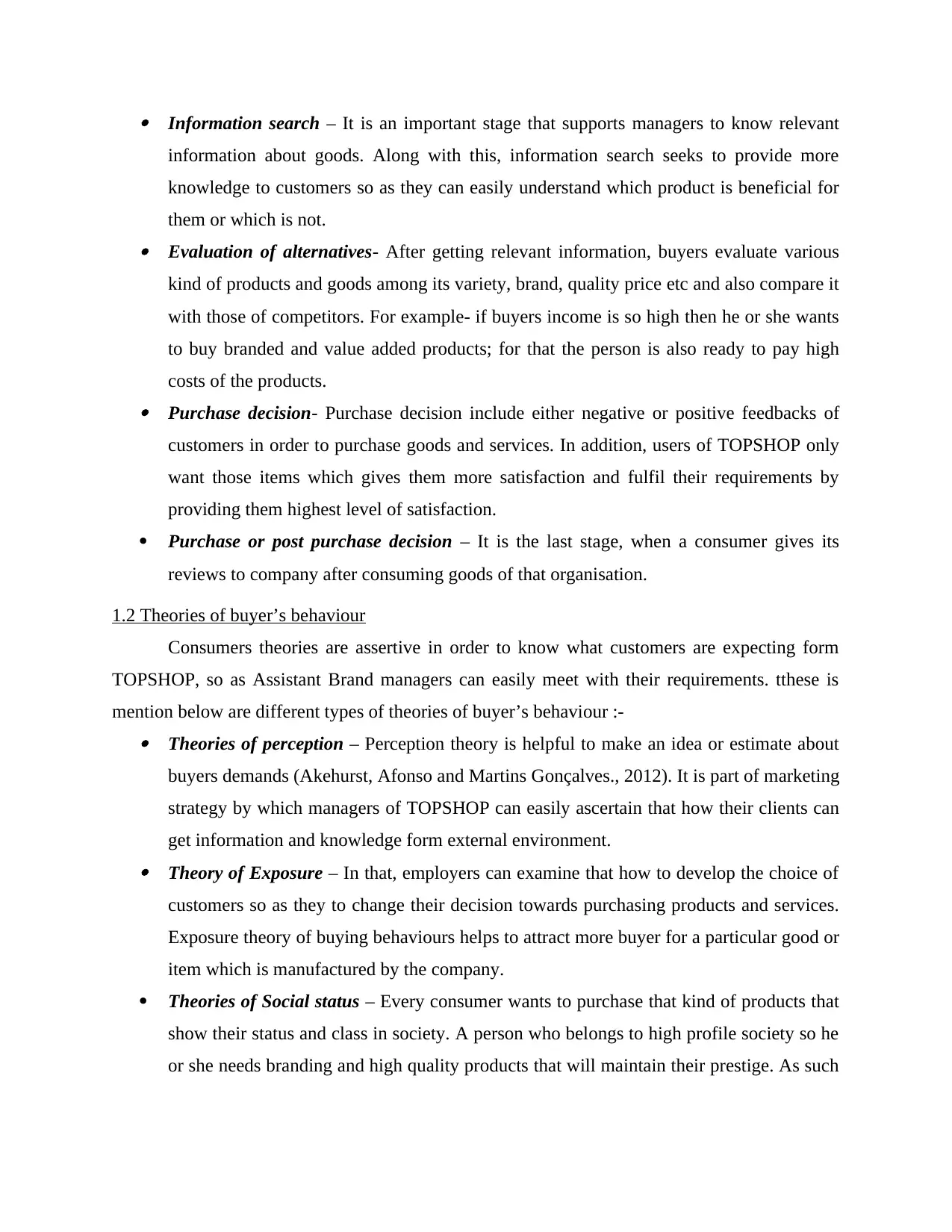
Information search – It is an important stage that supports managers to know relevant
information about goods. Along with this, information search seeks to provide more
knowledge to customers so as they can easily understand which product is beneficial for
them or which is not. Evaluation of alternatives- After getting relevant information, buyers evaluate various
kind of products and goods among its variety, brand, quality price etc and also compare it
with those of competitors. For example- if buyers income is so high then he or she wants
to buy branded and value added products; for that the person is also ready to pay high
costs of the products. Purchase decision- Purchase decision include either negative or positive feedbacks of
customers in order to purchase goods and services. In addition, users of TOPSHOP only
want those items which gives them more satisfaction and fulfil their requirements by
providing them highest level of satisfaction.
Purchase or post purchase decision – It is the last stage, when a consumer gives its
reviews to company after consuming goods of that organisation.
1.2 Theories of buyer’s behaviour
Consumers theories are assertive in order to know what customers are expecting form
TOPSHOP, so as Assistant Brand managers can easily meet with their requirements. tthese is
mention below are different types of theories of buyer’s behaviour :- Theories of perception – Perception theory is helpful to make an idea or estimate about
buyers demands (Akehurst, Afonso and Martins Gonçalves., 2012). It is part of marketing
strategy by which managers of TOPSHOP can easily ascertain that how their clients can
get information and knowledge form external environment. Theory of Exposure – In that, employers can examine that how to develop the choice of
customers so as they to change their decision towards purchasing products and services.
Exposure theory of buying behaviours helps to attract more buyer for a particular good or
item which is manufactured by the company.
Theories of Social status – Every consumer wants to purchase that kind of products that
show their status and class in society. A person who belongs to high profile society so he
or she needs branding and high quality products that will maintain their prestige. As such
information about goods. Along with this, information search seeks to provide more
knowledge to customers so as they can easily understand which product is beneficial for
them or which is not. Evaluation of alternatives- After getting relevant information, buyers evaluate various
kind of products and goods among its variety, brand, quality price etc and also compare it
with those of competitors. For example- if buyers income is so high then he or she wants
to buy branded and value added products; for that the person is also ready to pay high
costs of the products. Purchase decision- Purchase decision include either negative or positive feedbacks of
customers in order to purchase goods and services. In addition, users of TOPSHOP only
want those items which gives them more satisfaction and fulfil their requirements by
providing them highest level of satisfaction.
Purchase or post purchase decision – It is the last stage, when a consumer gives its
reviews to company after consuming goods of that organisation.
1.2 Theories of buyer’s behaviour
Consumers theories are assertive in order to know what customers are expecting form
TOPSHOP, so as Assistant Brand managers can easily meet with their requirements. tthese is
mention below are different types of theories of buyer’s behaviour :- Theories of perception – Perception theory is helpful to make an idea or estimate about
buyers demands (Akehurst, Afonso and Martins Gonçalves., 2012). It is part of marketing
strategy by which managers of TOPSHOP can easily ascertain that how their clients can
get information and knowledge form external environment. Theory of Exposure – In that, employers can examine that how to develop the choice of
customers so as they to change their decision towards purchasing products and services.
Exposure theory of buying behaviours helps to attract more buyer for a particular good or
item which is manufactured by the company.
Theories of Social status – Every consumer wants to purchase that kind of products that
show their status and class in society. A person who belongs to high profile society so he
or she needs branding and high quality products that will maintain their prestige. As such
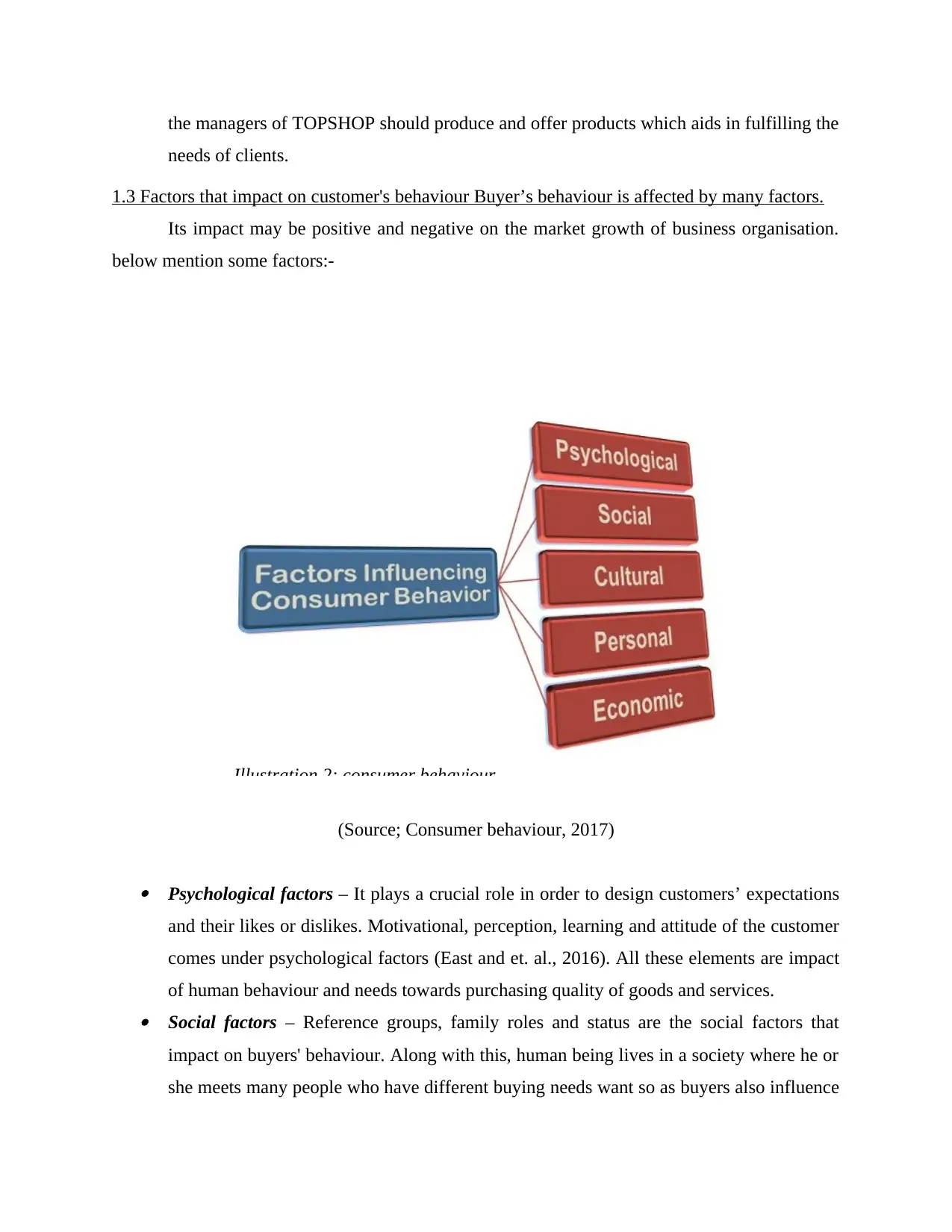
the managers of TOPSHOP should produce and offer products which aids in fulfilling the
needs of clients.
1.3 Factors that impact on customer's behaviour Buyer’s behaviour is affected by many factors.
Its impact may be positive and negative on the market growth of business organisation.
below mention some factors:-
(Source; Consumer behaviour, 2017)
Psychological factors – It plays a crucial role in order to design customers’ expectations
and their likes or dislikes. Motivational, perception, learning and attitude of the customer
comes under psychological factors (East and et. al., 2016). All these elements are impact
of human behaviour and needs towards purchasing quality of goods and services. Social factors – Reference groups, family roles and status are the social factors that
impact on buyers' behaviour. Along with this, human being lives in a society where he or
she meets many people who have different buying needs want so as buyers also influence
Illustration 2: consumer behaviour
needs of clients.
1.3 Factors that impact on customer's behaviour Buyer’s behaviour is affected by many factors.
Its impact may be positive and negative on the market growth of business organisation.
below mention some factors:-
(Source; Consumer behaviour, 2017)
Psychological factors – It plays a crucial role in order to design customers’ expectations
and their likes or dislikes. Motivational, perception, learning and attitude of the customer
comes under psychological factors (East and et. al., 2016). All these elements are impact
of human behaviour and needs towards purchasing quality of goods and services. Social factors – Reference groups, family roles and status are the social factors that
impact on buyers' behaviour. Along with this, human being lives in a society where he or
she meets many people who have different buying needs want so as buyers also influence
Illustration 2: consumer behaviour
⊘ This is a preview!⊘
Do you want full access?
Subscribe today to unlock all pages.

Trusted by 1+ million students worldwide
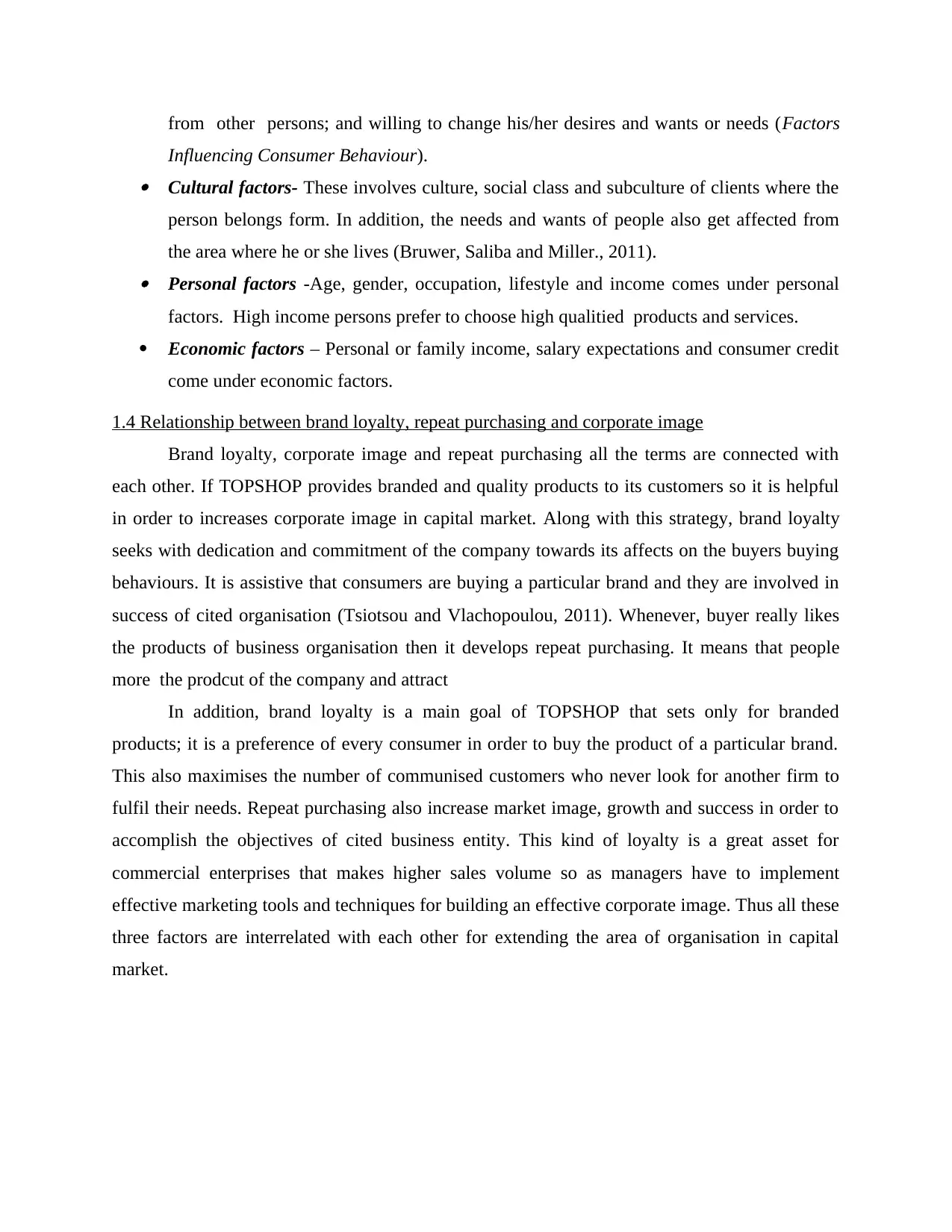
from other persons; and willing to change his/her desires and wants or needs (Factors
Influencing Consumer Behaviour). Cultural factors- These involves culture, social class and subculture of clients where the
person belongs form. In addition, the needs and wants of people also get affected from
the area where he or she lives (Bruwer, Saliba and Miller., 2011). Personal factors -Age, gender, occupation, lifestyle and income comes under personal
factors. High income persons prefer to choose high qualitied products and services.
Economic factors – Personal or family income, salary expectations and consumer credit
come under economic factors.
1.4 Relationship between brand loyalty, repeat purchasing and corporate image
Brand loyalty, corporate image and repeat purchasing all the terms are connected with
each other. If TOPSHOP provides branded and quality products to its customers so it is helpful
in order to increases corporate image in capital market. Along with this strategy, brand loyalty
seeks with dedication and commitment of the company towards its affects on the buyers buying
behaviours. It is assistive that consumers are buying a particular brand and they are involved in
success of cited organisation (Tsiotsou and Vlachopoulou, 2011). Whenever, buyer really likes
the products of business organisation then it develops repeat purchasing. It means that people
more the prodcut of the company and attract
In addition, brand loyalty is a main goal of TOPSHOP that sets only for branded
products; it is a preference of every consumer in order to buy the product of a particular brand.
This also maximises the number of communised customers who never look for another firm to
fulfil their needs. Repeat purchasing also increase market image, growth and success in order to
accomplish the objectives of cited business entity. This kind of loyalty is a great asset for
commercial enterprises that makes higher sales volume so as managers have to implement
effective marketing tools and techniques for building an effective corporate image. Thus all these
three factors are interrelated with each other for extending the area of organisation in capital
market.
Influencing Consumer Behaviour). Cultural factors- These involves culture, social class and subculture of clients where the
person belongs form. In addition, the needs and wants of people also get affected from
the area where he or she lives (Bruwer, Saliba and Miller., 2011). Personal factors -Age, gender, occupation, lifestyle and income comes under personal
factors. High income persons prefer to choose high qualitied products and services.
Economic factors – Personal or family income, salary expectations and consumer credit
come under economic factors.
1.4 Relationship between brand loyalty, repeat purchasing and corporate image
Brand loyalty, corporate image and repeat purchasing all the terms are connected with
each other. If TOPSHOP provides branded and quality products to its customers so it is helpful
in order to increases corporate image in capital market. Along with this strategy, brand loyalty
seeks with dedication and commitment of the company towards its affects on the buyers buying
behaviours. It is assistive that consumers are buying a particular brand and they are involved in
success of cited organisation (Tsiotsou and Vlachopoulou, 2011). Whenever, buyer really likes
the products of business organisation then it develops repeat purchasing. It means that people
more the prodcut of the company and attract
In addition, brand loyalty is a main goal of TOPSHOP that sets only for branded
products; it is a preference of every consumer in order to buy the product of a particular brand.
This also maximises the number of communised customers who never look for another firm to
fulfil their needs. Repeat purchasing also increase market image, growth and success in order to
accomplish the objectives of cited business entity. This kind of loyalty is a great asset for
commercial enterprises that makes higher sales volume so as managers have to implement
effective marketing tools and techniques for building an effective corporate image. Thus all these
three factors are interrelated with each other for extending the area of organisation in capital
market.
Paraphrase This Document
Need a fresh take? Get an instant paraphrase of this document with our AI Paraphraser
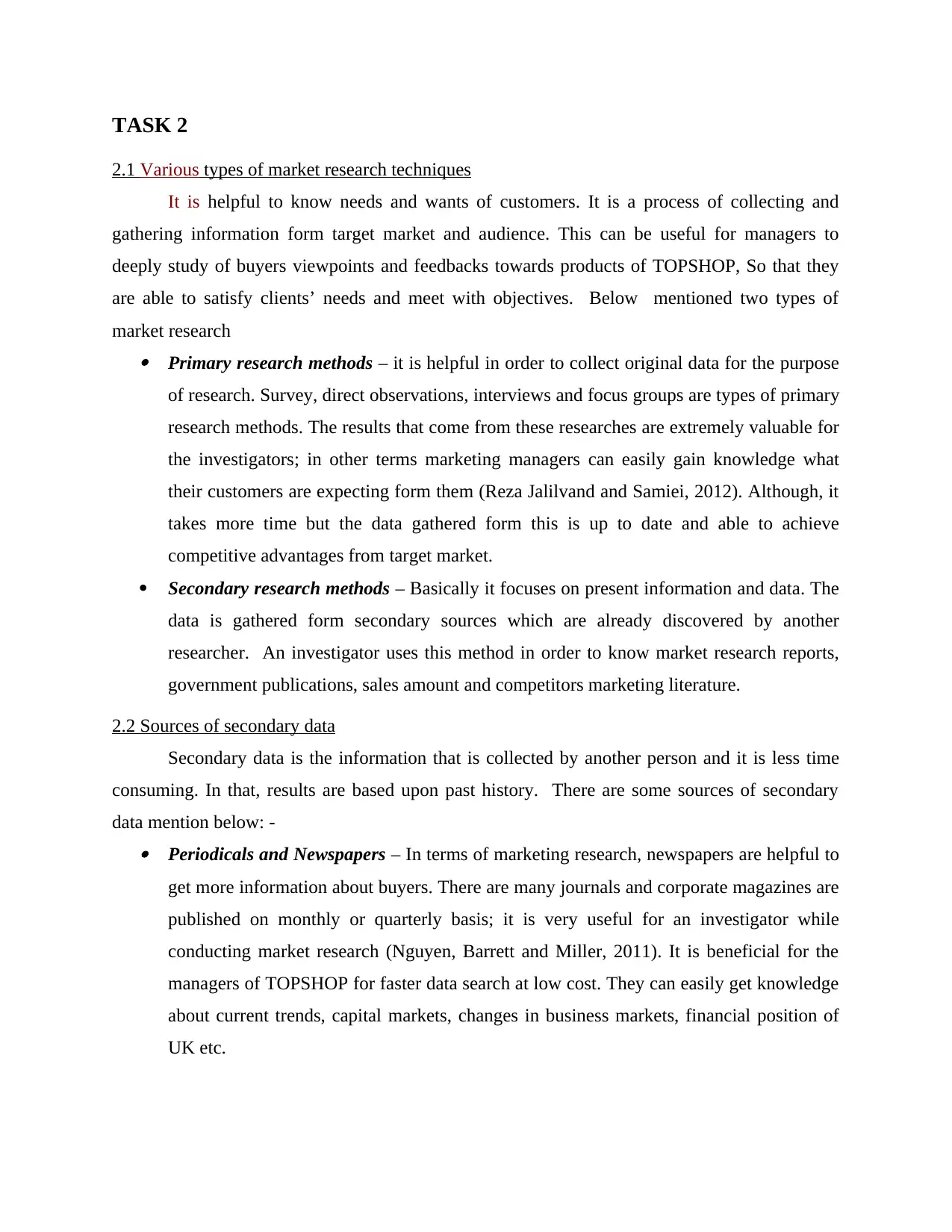
TASK 2
2.1 Various types of market research techniques
It is helpful to know needs and wants of customers. It is a process of collecting and
gathering information form target market and audience. This can be useful for managers to
deeply study of buyers viewpoints and feedbacks towards products of TOPSHOP, So that they
are able to satisfy clients’ needs and meet with objectives. Below mentioned two types of
market research Primary research methods – it is helpful in order to collect original data for the purpose
of research. Survey, direct observations, interviews and focus groups are types of primary
research methods. The results that come from these researches are extremely valuable for
the investigators; in other terms marketing managers can easily gain knowledge what
their customers are expecting form them (Reza Jalilvand and Samiei, 2012). Although, it
takes more time but the data gathered form this is up to date and able to achieve
competitive advantages from target market.
Secondary research methods – Basically it focuses on present information and data. The
data is gathered form secondary sources which are already discovered by another
researcher. An investigator uses this method in order to know market research reports,
government publications, sales amount and competitors marketing literature.
2.2 Sources of secondary data
Secondary data is the information that is collected by another person and it is less time
consuming. In that, results are based upon past history. There are some sources of secondary
data mention below: - Periodicals and Newspapers – In terms of marketing research, newspapers are helpful to
get more information about buyers. There are many journals and corporate magazines are
published on monthly or quarterly basis; it is very useful for an investigator while
conducting market research (Nguyen, Barrett and Miller, 2011). It is beneficial for the
managers of TOPSHOP for faster data search at low cost. They can easily get knowledge
about current trends, capital markets, changes in business markets, financial position of
UK etc.
2.1 Various types of market research techniques
It is helpful to know needs and wants of customers. It is a process of collecting and
gathering information form target market and audience. This can be useful for managers to
deeply study of buyers viewpoints and feedbacks towards products of TOPSHOP, So that they
are able to satisfy clients’ needs and meet with objectives. Below mentioned two types of
market research Primary research methods – it is helpful in order to collect original data for the purpose
of research. Survey, direct observations, interviews and focus groups are types of primary
research methods. The results that come from these researches are extremely valuable for
the investigators; in other terms marketing managers can easily gain knowledge what
their customers are expecting form them (Reza Jalilvand and Samiei, 2012). Although, it
takes more time but the data gathered form this is up to date and able to achieve
competitive advantages from target market.
Secondary research methods – Basically it focuses on present information and data. The
data is gathered form secondary sources which are already discovered by another
researcher. An investigator uses this method in order to know market research reports,
government publications, sales amount and competitors marketing literature.
2.2 Sources of secondary data
Secondary data is the information that is collected by another person and it is less time
consuming. In that, results are based upon past history. There are some sources of secondary
data mention below: - Periodicals and Newspapers – In terms of marketing research, newspapers are helpful to
get more information about buyers. There are many journals and corporate magazines are
published on monthly or quarterly basis; it is very useful for an investigator while
conducting market research (Nguyen, Barrett and Miller, 2011). It is beneficial for the
managers of TOPSHOP for faster data search at low cost. They can easily get knowledge
about current trends, capital markets, changes in business markets, financial position of
UK etc.
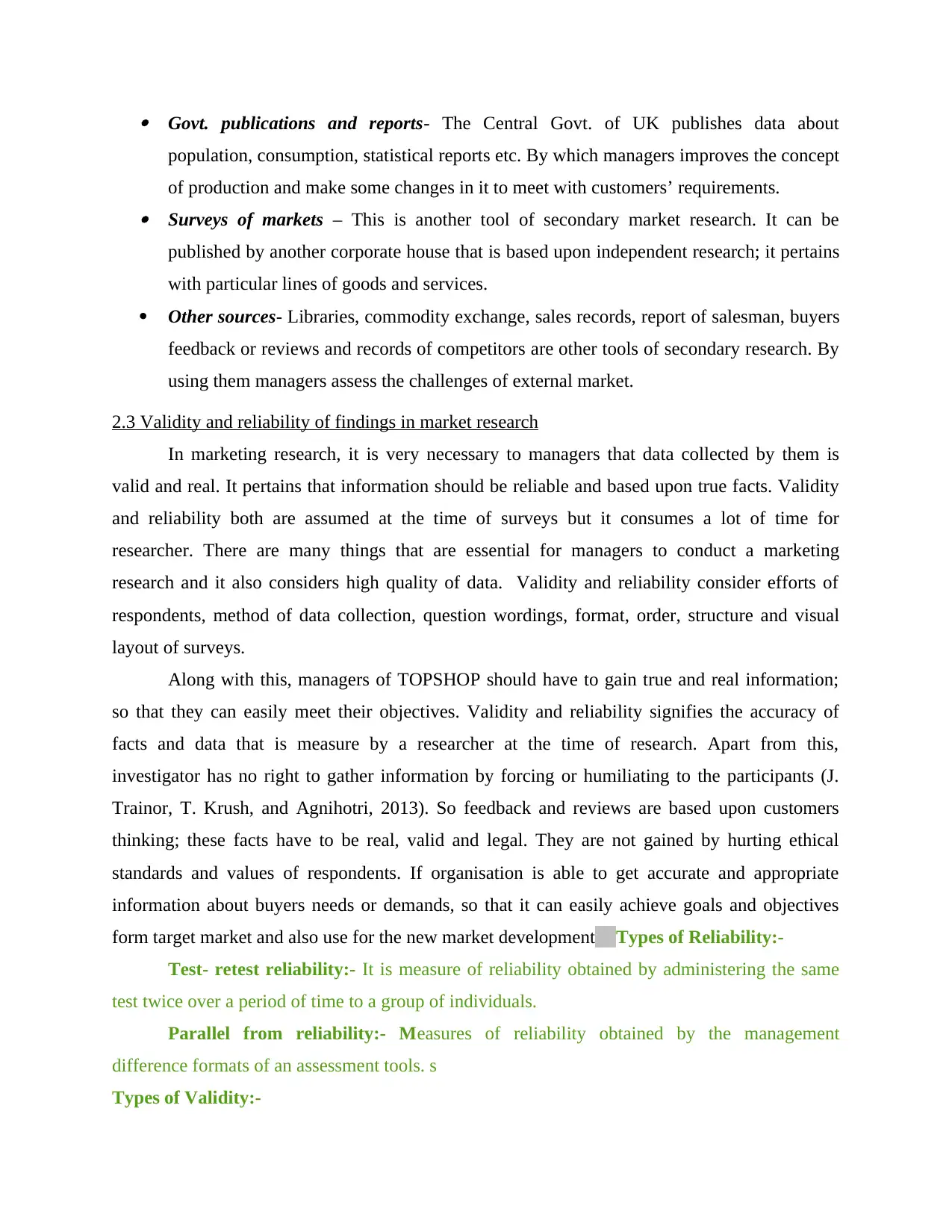
Govt. publications and reports- The Central Govt. of UK publishes data about
population, consumption, statistical reports etc. By which managers improves the concept
of production and make some changes in it to meet with customers’ requirements. Surveys of markets – This is another tool of secondary market research. It can be
published by another corporate house that is based upon independent research; it pertains
with particular lines of goods and services.
Other sources- Libraries, commodity exchange, sales records, report of salesman, buyers
feedback or reviews and records of competitors are other tools of secondary research. By
using them managers assess the challenges of external market.
2.3 Validity and reliability of findings in market research
In marketing research, it is very necessary to managers that data collected by them is
valid and real. It pertains that information should be reliable and based upon true facts. Validity
and reliability both are assumed at the time of surveys but it consumes a lot of time for
researcher. There are many things that are essential for managers to conduct a marketing
research and it also considers high quality of data. Validity and reliability consider efforts of
respondents, method of data collection, question wordings, format, order, structure and visual
layout of surveys.
Along with this, managers of TOPSHOP should have to gain true and real information;
so that they can easily meet their objectives. Validity and reliability signifies the accuracy of
facts and data that is measure by a researcher at the time of research. Apart from this,
investigator has no right to gather information by forcing or humiliating to the participants (J.
Trainor, T. Krush, and Agnihotri, 2013). So feedback and reviews are based upon customers
thinking; these facts have to be real, valid and legal. They are not gained by hurting ethical
standards and values of respondents. If organisation is able to get accurate and appropriate
information about buyers needs or demands, so that it can easily achieve goals and objectives
form target market and also use for the new market development Types of Reliability:-
Test- retest reliability:- It is measure of reliability obtained by administering the same
test twice over a period of time to a group of individuals.
Parallel from reliability:- Measures of reliability obtained by the management
difference formats of an assessment tools. s
Types of Validity:-
population, consumption, statistical reports etc. By which managers improves the concept
of production and make some changes in it to meet with customers’ requirements. Surveys of markets – This is another tool of secondary market research. It can be
published by another corporate house that is based upon independent research; it pertains
with particular lines of goods and services.
Other sources- Libraries, commodity exchange, sales records, report of salesman, buyers
feedback or reviews and records of competitors are other tools of secondary research. By
using them managers assess the challenges of external market.
2.3 Validity and reliability of findings in market research
In marketing research, it is very necessary to managers that data collected by them is
valid and real. It pertains that information should be reliable and based upon true facts. Validity
and reliability both are assumed at the time of surveys but it consumes a lot of time for
researcher. There are many things that are essential for managers to conduct a marketing
research and it also considers high quality of data. Validity and reliability consider efforts of
respondents, method of data collection, question wordings, format, order, structure and visual
layout of surveys.
Along with this, managers of TOPSHOP should have to gain true and real information;
so that they can easily meet their objectives. Validity and reliability signifies the accuracy of
facts and data that is measure by a researcher at the time of research. Apart from this,
investigator has no right to gather information by forcing or humiliating to the participants (J.
Trainor, T. Krush, and Agnihotri, 2013). So feedback and reviews are based upon customers
thinking; these facts have to be real, valid and legal. They are not gained by hurting ethical
standards and values of respondents. If organisation is able to get accurate and appropriate
information about buyers needs or demands, so that it can easily achieve goals and objectives
form target market and also use for the new market development Types of Reliability:-
Test- retest reliability:- It is measure of reliability obtained by administering the same
test twice over a period of time to a group of individuals.
Parallel from reliability:- Measures of reliability obtained by the management
difference formats of an assessment tools. s
Types of Validity:-
⊘ This is a preview!⊘
Do you want full access?
Subscribe today to unlock all pages.

Trusted by 1+ million students worldwide
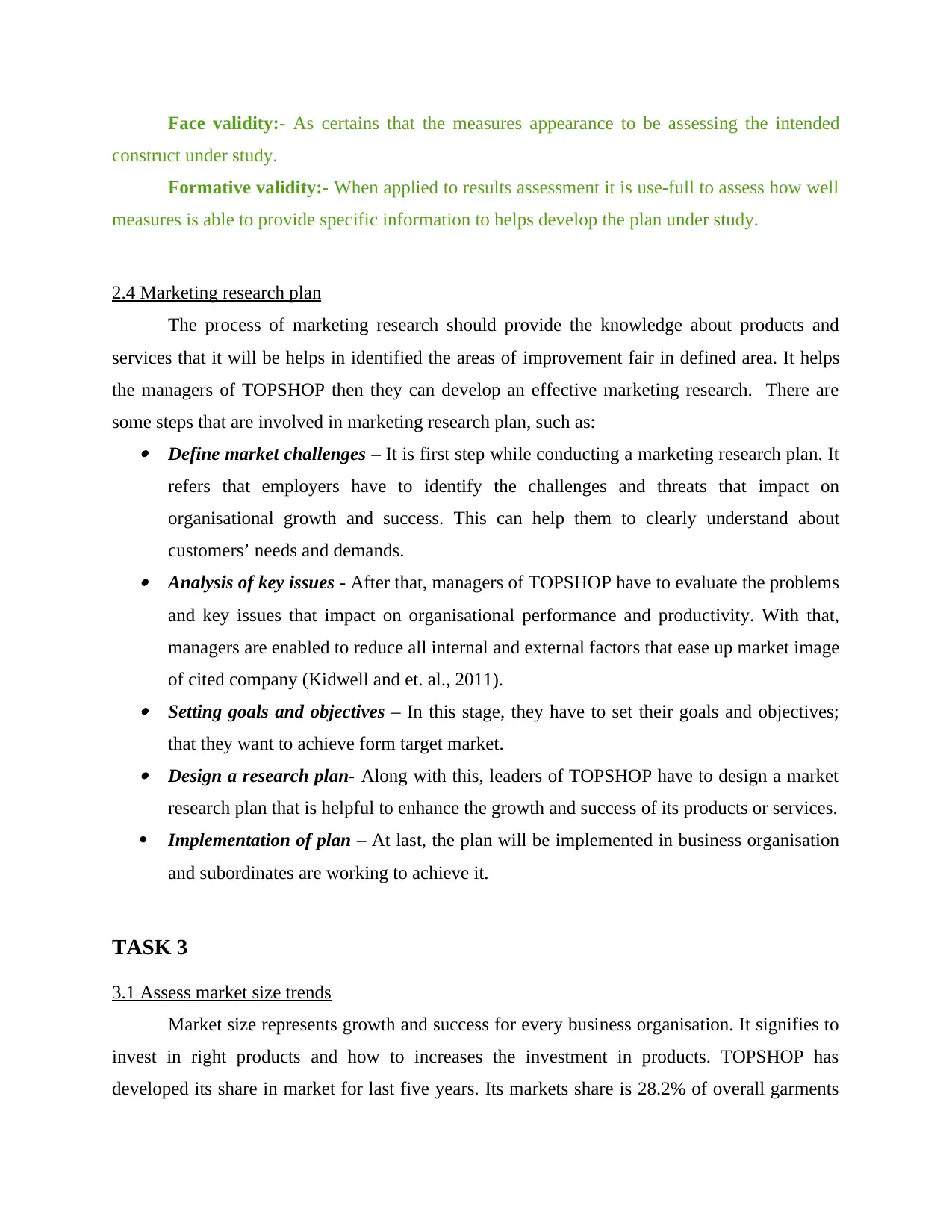
Face validity:- As certains that the measures appearance to be assessing the intended
construct under study.
Formative validity:- When applied to results assessment it is use-full to assess how well
measures is able to provide specific information to helps develop the plan under study.
2.4 Marketing research plan
The process of marketing research should provide the knowledge about products and
services that it will be helps in identified the areas of improvement fair in defined area. It helps
the managers of TOPSHOP then they can develop an effective marketing research. There are
some steps that are involved in marketing research plan, such as: Define market challenges – It is first step while conducting a marketing research plan. It
refers that employers have to identify the challenges and threats that impact on
organisational growth and success. This can help them to clearly understand about
customers’ needs and demands. Analysis of key issues - After that, managers of TOPSHOP have to evaluate the problems
and key issues that impact on organisational performance and productivity. With that,
managers are enabled to reduce all internal and external factors that ease up market image
of cited company (Kidwell and et. al., 2011). Setting goals and objectives – In this stage, they have to set their goals and objectives;
that they want to achieve form target market. Design a research plan- Along with this, leaders of TOPSHOP have to design a market
research plan that is helpful to enhance the growth and success of its products or services.
Implementation of plan – At last, the plan will be implemented in business organisation
and subordinates are working to achieve it.
TASK 3
3.1 Assess market size trends
Market size represents growth and success for every business organisation. It signifies to
invest in right products and how to increases the investment in products. TOPSHOP has
developed its share in market for last five years. Its markets share is 28.2% of overall garments
construct under study.
Formative validity:- When applied to results assessment it is use-full to assess how well
measures is able to provide specific information to helps develop the plan under study.
2.4 Marketing research plan
The process of marketing research should provide the knowledge about products and
services that it will be helps in identified the areas of improvement fair in defined area. It helps
the managers of TOPSHOP then they can develop an effective marketing research. There are
some steps that are involved in marketing research plan, such as: Define market challenges – It is first step while conducting a marketing research plan. It
refers that employers have to identify the challenges and threats that impact on
organisational growth and success. This can help them to clearly understand about
customers’ needs and demands. Analysis of key issues - After that, managers of TOPSHOP have to evaluate the problems
and key issues that impact on organisational performance and productivity. With that,
managers are enabled to reduce all internal and external factors that ease up market image
of cited company (Kidwell and et. al., 2011). Setting goals and objectives – In this stage, they have to set their goals and objectives;
that they want to achieve form target market. Design a research plan- Along with this, leaders of TOPSHOP have to design a market
research plan that is helpful to enhance the growth and success of its products or services.
Implementation of plan – At last, the plan will be implemented in business organisation
and subordinates are working to achieve it.
TASK 3
3.1 Assess market size trends
Market size represents growth and success for every business organisation. It signifies to
invest in right products and how to increases the investment in products. TOPSHOP has
developed its share in market for last five years. Its markets share is 28.2% of overall garments
Paraphrase This Document
Need a fresh take? Get an instant paraphrase of this document with our AI Paraphraser
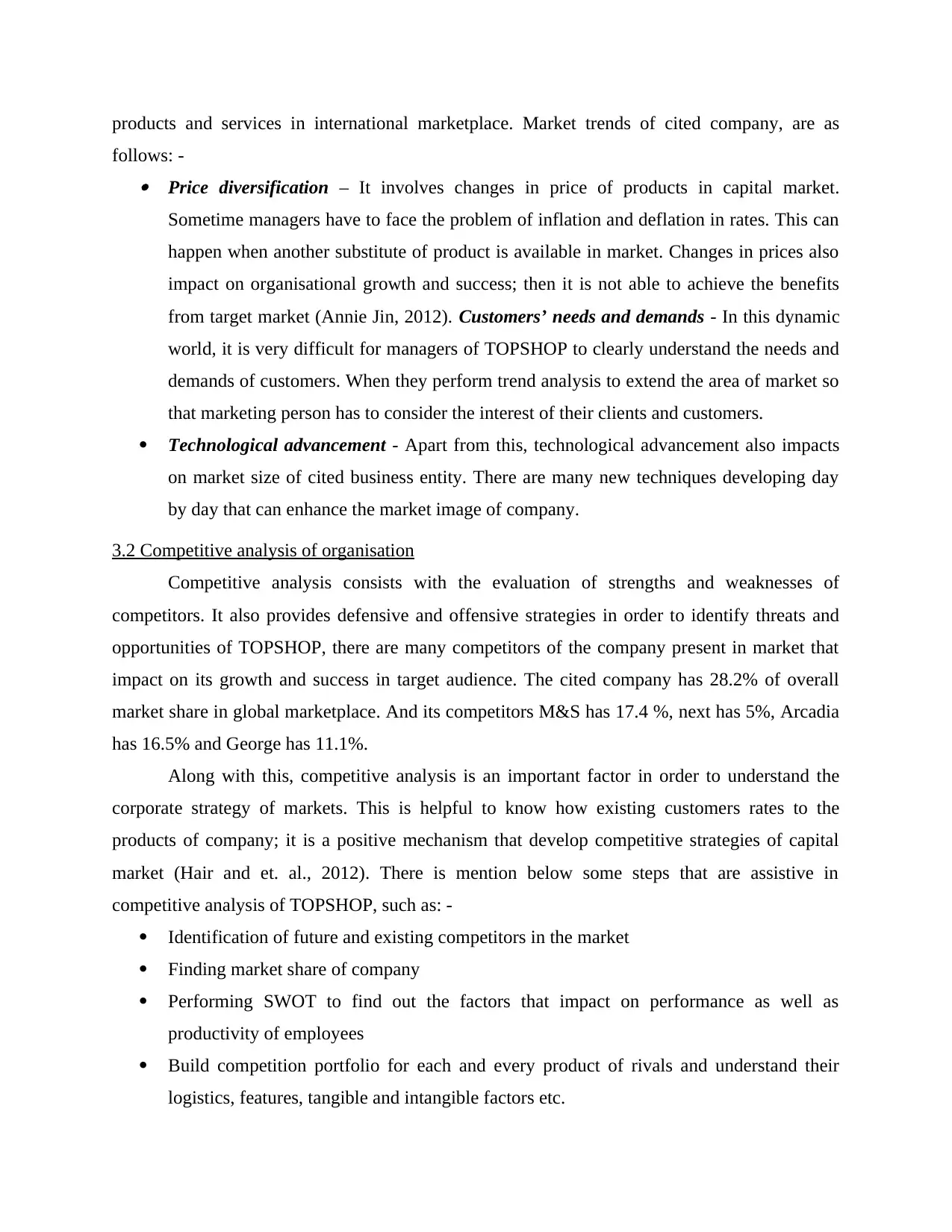
products and services in international marketplace. Market trends of cited company, are as
follows: - Price diversification – It involves changes in price of products in capital market.
Sometime managers have to face the problem of inflation and deflation in rates. This can
happen when another substitute of product is available in market. Changes in prices also
impact on organisational growth and success; then it is not able to achieve the benefits
from target market (Annie Jin, 2012). Customers’ needs and demands - In this dynamic
world, it is very difficult for managers of TOPSHOP to clearly understand the needs and
demands of customers. When they perform trend analysis to extend the area of market so
that marketing person has to consider the interest of their clients and customers.
Technological advancement - Apart from this, technological advancement also impacts
on market size of cited business entity. There are many new techniques developing day
by day that can enhance the market image of company.
3.2 Competitive analysis of organisation
Competitive analysis consists with the evaluation of strengths and weaknesses of
competitors. It also provides defensive and offensive strategies in order to identify threats and
opportunities of TOPSHOP, there are many competitors of the company present in market that
impact on its growth and success in target audience. The cited company has 28.2% of overall
market share in global marketplace. And its competitors M&S has 17.4 %, next has 5%, Arcadia
has 16.5% and George has 11.1%.
Along with this, competitive analysis is an important factor in order to understand the
corporate strategy of markets. This is helpful to know how existing customers rates to the
products of company; it is a positive mechanism that develop competitive strategies of capital
market (Hair and et. al., 2012). There is mention below some steps that are assistive in
competitive analysis of TOPSHOP, such as: -
Identification of future and existing competitors in the market
Finding market share of company
Performing SWOT to find out the factors that impact on performance as well as
productivity of employees
Build competition portfolio for each and every product of rivals and understand their
logistics, features, tangible and intangible factors etc.
follows: - Price diversification – It involves changes in price of products in capital market.
Sometime managers have to face the problem of inflation and deflation in rates. This can
happen when another substitute of product is available in market. Changes in prices also
impact on organisational growth and success; then it is not able to achieve the benefits
from target market (Annie Jin, 2012). Customers’ needs and demands - In this dynamic
world, it is very difficult for managers of TOPSHOP to clearly understand the needs and
demands of customers. When they perform trend analysis to extend the area of market so
that marketing person has to consider the interest of their clients and customers.
Technological advancement - Apart from this, technological advancement also impacts
on market size of cited business entity. There are many new techniques developing day
by day that can enhance the market image of company.
3.2 Competitive analysis of organisation
Competitive analysis consists with the evaluation of strengths and weaknesses of
competitors. It also provides defensive and offensive strategies in order to identify threats and
opportunities of TOPSHOP, there are many competitors of the company present in market that
impact on its growth and success in target audience. The cited company has 28.2% of overall
market share in global marketplace. And its competitors M&S has 17.4 %, next has 5%, Arcadia
has 16.5% and George has 11.1%.
Along with this, competitive analysis is an important factor in order to understand the
corporate strategy of markets. This is helpful to know how existing customers rates to the
products of company; it is a positive mechanism that develop competitive strategies of capital
market (Hair and et. al., 2012). There is mention below some steps that are assistive in
competitive analysis of TOPSHOP, such as: -
Identification of future and existing competitors in the market
Finding market share of company
Performing SWOT to find out the factors that impact on performance as well as
productivity of employees
Build competition portfolio for each and every product of rivals and understand their
logistics, features, tangible and intangible factors etc.
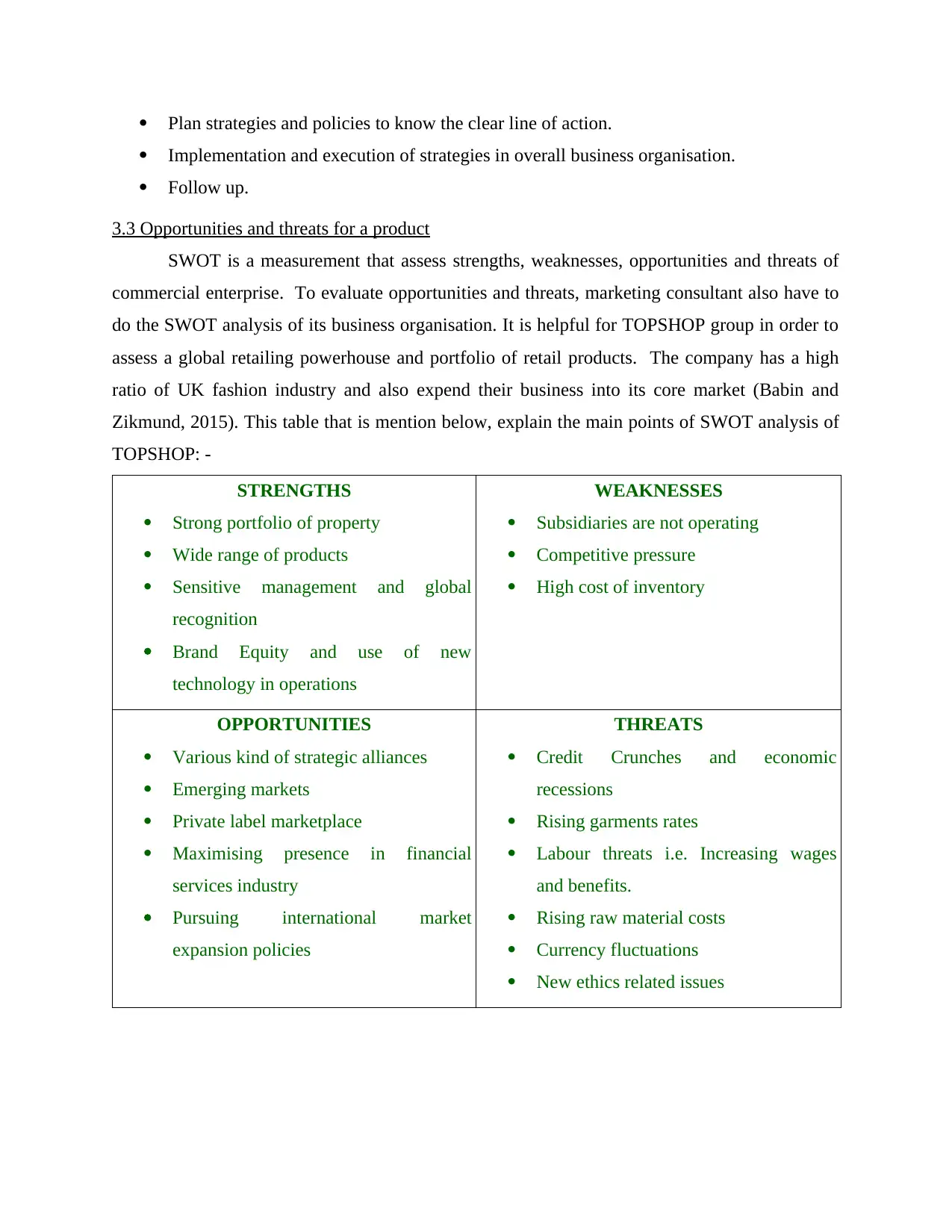
Plan strategies and policies to know the clear line of action.
Implementation and execution of strategies in overall business organisation.
Follow up.
3.3 Opportunities and threats for a product
SWOT is a measurement that assess strengths, weaknesses, opportunities and threats of
commercial enterprise. To evaluate opportunities and threats, marketing consultant also have to
do the SWOT analysis of its business organisation. It is helpful for TOPSHOP group in order to
assess a global retailing powerhouse and portfolio of retail products. The company has a high
ratio of UK fashion industry and also expend their business into its core market (Babin and
Zikmund, 2015). This table that is mention below, explain the main points of SWOT analysis of
TOPSHOP: -
STRENGTHS
Strong portfolio of property
Wide range of products
Sensitive management and global
recognition
Brand Equity and use of new
technology in operations
WEAKNESSES
Subsidiaries are not operating
Competitive pressure
High cost of inventory
OPPORTUNITIES
Various kind of strategic alliances
Emerging markets
Private label marketplace
Maximising presence in financial
services industry
Pursuing international market
expansion policies
THREATS
Credit Crunches and economic
recessions
Rising garments rates
Labour threats i.e. Increasing wages
and benefits.
Rising raw material costs
Currency fluctuations
New ethics related issues
Implementation and execution of strategies in overall business organisation.
Follow up.
3.3 Opportunities and threats for a product
SWOT is a measurement that assess strengths, weaknesses, opportunities and threats of
commercial enterprise. To evaluate opportunities and threats, marketing consultant also have to
do the SWOT analysis of its business organisation. It is helpful for TOPSHOP group in order to
assess a global retailing powerhouse and portfolio of retail products. The company has a high
ratio of UK fashion industry and also expend their business into its core market (Babin and
Zikmund, 2015). This table that is mention below, explain the main points of SWOT analysis of
TOPSHOP: -
STRENGTHS
Strong portfolio of property
Wide range of products
Sensitive management and global
recognition
Brand Equity and use of new
technology in operations
WEAKNESSES
Subsidiaries are not operating
Competitive pressure
High cost of inventory
OPPORTUNITIES
Various kind of strategic alliances
Emerging markets
Private label marketplace
Maximising presence in financial
services industry
Pursuing international market
expansion policies
THREATS
Credit Crunches and economic
recessions
Rising garments rates
Labour threats i.e. Increasing wages
and benefits.
Rising raw material costs
Currency fluctuations
New ethics related issues
⊘ This is a preview!⊘
Do you want full access?
Subscribe today to unlock all pages.

Trusted by 1+ million students worldwide
1 out of 18
Related Documents
Your All-in-One AI-Powered Toolkit for Academic Success.
+13062052269
info@desklib.com
Available 24*7 on WhatsApp / Email
![[object Object]](/_next/static/media/star-bottom.7253800d.svg)
Unlock your academic potential
Copyright © 2020–2025 A2Z Services. All Rights Reserved. Developed and managed by ZUCOL.





